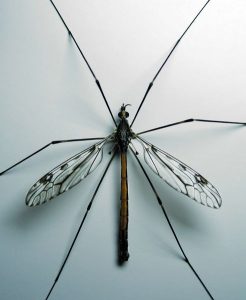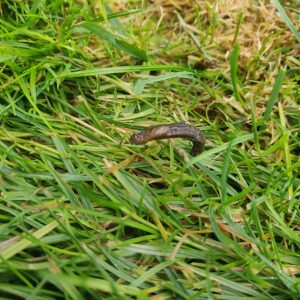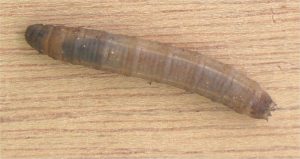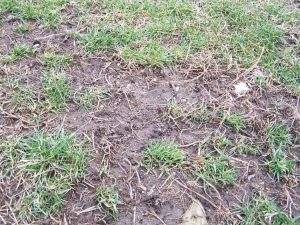Most of us know what a Daddy Long-leg looks like. This flying insect is harmless enough, but the larvae that comes before it is a major lawn pest. Let’s take a look at dealing with Leather Jackets in your lawn.

CraneFly
Lifecycle of a cranefly
Before it becomes a flying insect, the crane fly is a larvae living in soil, just below the surface (they move deeper down in colder weather). In autumn the larvae pupate – much like a caterpillar becoming a butterfly. It emerges from the soil, leaving behind its casing and flies off to find a mate. Females then return to the soil to lay eggs and start the process all over again.
Whilst it is a flying insect it causes no issue for the gardener. Even though it looks like a large mosquito, it doesn’t bite or sting humans and certainly causes no issues for grass.

Do I have Leather Jackets in my lawn?
Leather jackets live in soil and eat the roots of plants. They can also emerge from the soil, often at night and eat the crown or leaf of the grass plant, causing excessive thinning and die-back. If your lawn is showing signs of poor growth, it is important to investigate within the soil to see whether you can find evidence of the grubs present. Look carefully though as they can be hard to spot. On damp autumn mornings you will often find crane fly on the surface of your lawn, taking to flight as you walk close to them, and they are disturbed. This is often a good indication of a Leather Jacket infestation.

Leather Jackets and new turf
We are seeing increased evidence of the grubs being brought in when new turf is laid on site. The reason for this is unclear, however there could well be two factors at play. Firstly, there is no longer any licenced chemical control for this common lawn pest. Populations have increased as a result. This means that turf growers are no longer able to spray to kill the larvae in their crop. Secondly, crane fly particularly like to lay eggs in bare soil. Once turf is harvested the soil is bare whilst new grass seed germinates in the field. It is for this reason that we often recommend starting a new lawn from seed rather than buying in turf and risk bringing in pests too.

Dealing with Leather Jackets in my lawn
As mentioned, there is no chemical control available to kill this common lawn pest. Damp summers and mild winters will increase the population, as more juveniles survive to cause extensive damage in the spring and summer of the following year. A microscopic worm called a nematode can be applied to the lawn and watered in. These then borrow into the body of the Leather Jacket and cause it to die. Results can be varied and it’s important to follow the instructions carefully for greatest effect.
Repairing a lawn damaged by Leather Jackets
Often much can be done to repair a damaged lawn rather than lifting the turf and starting all over again. Aerate the lawn to encourage root development and make it easier for nematodes to enter the soil. Apply nematodes, over-seed the lawn and apply top-dressing to create the best growing conditions. Applying a fertiliser specially formulated for root development will help your existing lawn grass recover from the damage it has already suffered. Autumn is the best time of year to carry out this work but it can also be done in the spring. If you need some help, speak with a lawn care professional.
Since the publication of this article we now have access to licenced insecticide for the control of leather jackets and chafer grubs. Read more here > Controlling Leather Jackets and Chafer Grubs in Lawns

 Established 2016
Established 2016



